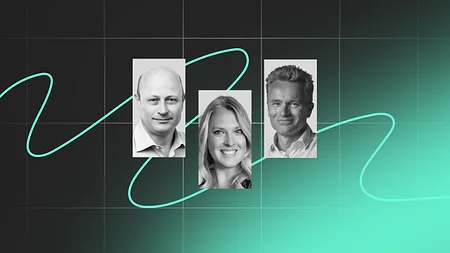Mike Kelly on Curl, Open Banking, and Hands Free Payments
Simon Taylor interviewed Mike Kelly, CEO and founder of Curl for Fintech Insider, a new payments network.
They discuss Curl’s origin story, their payments network and how Open Banking is going to make a huge difference.
Listen to the interview in full on the podcast here or stream it below or catch the highlights on YouTube.
What is Curl?
To kick things off, we ask Mike to define, what IS Curl? “Curl is a new payment network, designed from scratch, around merchants and consumers. It works via usernames and bank transfers, and is built around Open Banking, and the opportunities that have developed in the market.” rattles off Mike.“Curl is a new payment network, designed from scratch, around merchants and consumers. It works via usernames and bank transfers, and is built around Open Banking, and the opportunities that have developed in the market.”Simon asks him to give us more information on the username functionality and why it’s important to the Curl network: "It works very much the same as Twitter, or Instagram. The reason we picked that is because it's a commonly understood idiom for identity. So, that's a fancy way of saying, everybody's used to having Twitter handles and Instagram handles, and so we thought, building a network based around that same idea of identity, was actually quite a powerful concept." And how does the network itself work? Playing down suggestions that it’s like Square Cashtag, Mike tells us that the network has been built from scratch using open banking APIs, it does not sit on top of existing banking platforms. “it's kind of an abstraction layer for interaction above the layer of sort code and account numbers.”
Business model
So how does the Curl business model work? Who are their customers? The biggest revenue generator appears to be reduced transaction fees. Merchants are charged per transaction with Curl which is at least 50% less than the standard fees from card providers. This is based on the belief that transaction fees as they stand now are beginning to be phased out and will cease to be in 15-20 years time. Likewise, data collected by the smart payments and digital receipts collated in the app, can be accessed by the merchants so they can get aggregated insights into their customers, on a platform, not via reports.As such, retailers are their main customers, but they also have a relationship with consumers themselves. As such Mike calls the Curl app a “cross-products” app, offering services to both: “When you build a network, you're faced with a chicken and egg scenario, a two-sided market where if you don't have consumers, then it has no value to merchants, if you don't have any merchants, it doesn't have value to consumers.""If you don't have consumers, then it has no value to merchants, if you don't have any merchants, it doesn't have value to consumers.”Who are these customers? “We’ve spent the last 12, 18 months in a R&D phase, where we've been building the proposition, testing it with merchants. What we're doing this year is we're working with independent coffee chains, independent coffee shops in east London, basically to start the ball rolling on that rollout process.” The basic aim of Curl we’re told is to push customers from paying with card to paying with Curl. Simon asks the tough question: why should retailers move from the standard Visa/Mastercard model to Curl? Cost effectiveness as previously discussed is the main drive: "we're at least 50% of whatever they're being charged by their card processor, which, for a large organisation that's not an insignificant entry in their P&L. So, that, in and of itself, is fairly compelling.”
"we're at least 50% of whatever they're being charged by their card processor, which, for a large organisation that's not an insignificant entry in their P&L."Additionally, he also talks about Curls’ “push-based mechanism”. This is a change in traditional payments models where the retailer pulls the money from your account, with Curl, “when a retailer takes a payment from a customer, they send a request for payment. So, they'll ask you to pay them, they don't take the token from you and pull the money out of your bank account.”. Why is this important? “To cut a long story short, that leaves the merchant in a situation where they have no liability for fraud on our network, so they don't have to deal with anything like PCI DSS, and they don't have to deal with handling sensitive information like credit card details.”
Open Banking
Onto the topic of the moment: what does the arrival of open banking mean for Curl? “The most important thing, for us, is that Open Banking is on the agenda of major UK retail banks. For the first time, it's made building a new payment network possible. Up until now, the banks have, effectively, kind of, monopolised control over a customer's account. They control which pipes get connected to the account that you have with them, and that's been the case forever. What Open Banking has done is massively shifted the tables, and it's given autonomy to consumers and merchants, and it's made building a network that's designed around the needs of consumers and merchants possible, because banks no longer hold control over the customer's account.”"What Open Banking has done is massively shifted the tables, and it's given autonomy to consumers and merchants, and it's made building a network that's designed around the needs of consumers and merchants possible, because banks no longer hold control over the customer's account.”This sounds like good news for Curl but in Simon’s words, it also sounds like a lot of stick for the banks and no carrot. Where is the upside? Alongside reduced transaction fees, Mike says another key component of their business model that banks should like is “ instalment credit at the point of sale.” This is exemplified as follows: “if you were buying a £5,000 TV, and you were at the point of sale, through the card network, you'd be able to ask the finance world, 'Okay, I want to pay with this over six months. What would that cost me?' and allow the banks to be able to provide that credit product on demand. And that's quite interesting for the bank, for a couple of reasons. First of all, it's a completely new product, it's a new revenue line for them, which, obviously, is a good thing. But secondly, it's a much more efficient way of the bank being able to deliver credit to customers. If you have a £10,000 credit line on a credit card, from the bank's point of view, that sits on their balance sheet, but you might only, let's say, use £3,000, £4,000 of that credit. So, the rest of that credit is dead, but it sits on the bank's balance sheet. Whereas, if, instead, the bank is allocating the credit at the point of need, it's a much more efficient way of the bank allocating credit, so it's less costly for them, and more efficient overall.”
Changing users’ behaviour
Another big part of Curl’s mission is to change user behaviour and customer experience via the app, especially for small to medium sized businesses that don’t have the resource to build their own bespoke app. “If you're a Starbucks, or bigger retailer, potentially you have the kind of distribution to get away with having your own app, but if you're a SME-style retailer, encouraging a consumer to have an app for every single retailer they deal with is not great. So, a lot of those features that those small/medium-sized businesses want to see in a bespoke app for their brand, we can build those features on to the network, and, therefore, they can provide that digital experience to the customer, without all the overhead of having their own app.” Simon turns this question back around, reasoning that if customers only have 4 or 5 main apps they use, how can Curl make sure they’re one of them? Mike believes Curl are finding a market niche that has not yet been explored by the tech giants: “ I think Facebook, or any of the big technology companies that already have consumer distribution, could start to enter this space, and almost definitely will. There's a few propositions that are starting entering into peer to peer but there's nobody who's really looking about the consumer experience, in-store and online, from a consumer payments perspective. So, we're focusing on that angle to begin with, because we think we can create a step change in customer experience.”"There's nobody who's really looking about the consumer experience, in-store and online, from a consumer payments perspective.“We've done a lot of user research, both with merchants and with end consumers, if Facebook, or any of the other tech vendors, want to come in to this space, beyond peer to peer payments, I think there's a fair bit of product development that needs to happen. It's not just something where you plug a PSD2 rail in to your Facebook account, and then everybody starts paying each other. There's a fair bit of work that needs to be done, to develop the proposition.” A bold claim. Watch this space.
Hands free payments
The final piece in the Curl user experience puzzle is a service Mike calls “hands free payments”, which involves giving a trusted retailer the right to withdraw payment via the Curl app without you having to authorise it every time, giving you a seamless experience, and no transaction physically takes place. "If you went to the coffee shop every day, you have a relationship with them, you trust them, you can actually give them, on the network, what we call a hands-free permission. And what that means is, you walk up with your phone in your pocket, the phone tells the point of sale who you are, you say, 'I want my regular cappuccino,' they send you the payment request, and your hands-free permission picks it up and pays for it for you. Your phone stays in your pocket, you get a push notification confirming that a transaction has been made, you're left with a digital receipt on your phone, but you didn't have to do anything. You had a completely seamless experience.”"You walk up with your phone in your pocket, the phone tells the point of sale who you are, you say, 'I want my regular cappuccino,' they send you the payment request, and your hands-free permission picks it up and pays for it for you."Simon questions the security of this and the likelihood of fraud, “there's a lot that we can do around anti-fraud. Obviously, we can use geolocation, from a hands-free point of view, but this is a permission that you would only grant to retailers that you trust and we will basically put a limit on that, let's say it's £10, £20, £30, something similar to contactless, but it's only actually granted to the retailers that you have a trusted relationship with.”
What’s next for Curl?
"The most important metric for us is that we grow. We need to acquire merchants, that are encouraging their customer to pay with Curl, we need to see growth. And that's what we we're focusing on this year." Simon asks about the risks to Curl. Mike is very open about the possible risks both from delayed open banking timescales to the tech giants swooping in and taking market share first: “There's competitive risk, obviously., Amazon have a proposition called Amazon Pay, there's many parties looking to get in to this space. Clearly, there's a risk around Open Banking, so, right now, one of the banks has delivered on their Open Banking obligations, there's another eight banks that are still yet to deliver, so, there's definitely a risk that this stuff doesn't pan out in the timescales that we need.” Both the biggest risk and the biggest thing Curl needs to do next is grow. Only with growth can all of their plans and goals come into fruition: “The biggest risk is growth, We are creating value for merchants, which is creating value for users, and changing their behaviour. If we can't do that, then we don't have a business.”“The biggest risk is growth, We are creating value for merchants, which is creating value for users, and changing their behaviour. If we can't do that, then we don't have a business.”Listen to the interview in full here. To find out more about Curl go to paywithcurl.com or @paywithcurl on Twitter. To ensure you never miss an episode, subscribe to Fintech Insider now! Come talk to us @11FSTeam or @FintechInsiders on Twitter or hello@11fs.com if you want to send us an email.




